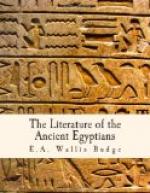It is probable that in one form or another many of the Chapters were in existence in the predynastic period,[1] but no copies of such primitive versions, if they ever existed, have come down to us. One Egyptian tradition, which is at least as old as the early part of the eighteenth dynasty (1600 B.C.), states that Chapters XXXB and LXIV were “discovered” during the reign of Semti, a king of the first dynasty, and another tradition assigns their discovery to the reign of Menkaura (the Mycerinus of classical writers), a king of the fourth dynasty. It is certain, however, that the Egyptians possessed a Book of the Dead which was used for kings and royal personages, at least, early under the first dynasty, and that, in a form more or less complete, it was in use down to the time of the coming of Christianity into Egypt. The tombs of the officials of the third and fourth dynasties prove that the Book of Opening the Mouth and the Liturgy of Funerary Offerings (see pp. 13-18) were in use when they were made, and this being so it follows as a matter of course that at this period the Egyptians believed in the resurrection of the dead and in their immortality, that the religion of Osiris was generally accepted, that the efficacy of funerary offerings was unquestioned by the religious, and that men died believing that those who were righteous on earth would be rewarded in heaven, and that the evil-doer would be punished. The Pyramid Texts also prove that a Book of the Dead divided into chapters was in existence when they were written, for they mention the “Chapter of those who come forth (i.e. appear in heaven),” and the “Chapter of those who rise up” (Pepi I, l. 463), and the “Chapter of the betu incense,” and the “Chapter of the natron incense” (Pepi I, 469). Whether these Chapters formed parts of the Pyramid Texts, or whether both they and the Pyramid Texts belonged to the Book of the Dead cannot be said, but it seems clear that the four Chapters mentioned above formed part of a work belonging to a Book of the Dead that was older than the Pyramid Texts. This Book of the Dead was no doubt based upon the beliefs of the followers of the religion of Osiris, which began in the Delta and spread southwards into Upper Egypt. Its doctrines must have differed in many important particulars from those of the worshippers of the Sun-god of Heliopolis, whose priests preached the existence of a heaven of a solar character, and taught their followers to believe in the Sun-god Ra, and not in Temu, the ancient native god of Heliopolis, and not in the divine man Osiris. The exposition of the Heliopolitan creed is found in the Pyramid Texts, which also contain the proofs that before the close of the sixth dynasty the cult of Osiris had vanquished the cult of Ra, and that the religion of Osiris had triumphed.
[Footnote 1: i.e. before Menes became king of both Upper and Lower Egypt.]




